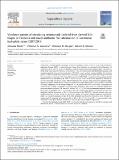| dc.description.abstract | Aeromonads are gram-negative, rod-shaped, facultative anaerobes bacteria known to cause motile aeromonads septicemia diseases (MAS) in warm freshwater farmed fish. Outbreaks are associated with pathogenicity of aeromonads in fish which is partly contributed by virulence characteristics of the etiological agent. The objective of this study was to assess the virulence characteristics of the previously isolated and identified aeromonads, and attenuate potential Aeromonas hydrophila strain TZR7-2018 to serve as local vaccine candidate. Six virulence genes and other virulence characteristics were molecularly and phenotypically assessed both using in-vitro and in-vivo approaches. Attenuation of A. hydrophila parent strain TZR7-2018+ was performed by passaging through thermal continuous sub-culturing 40 times in Tryptic soy agar (TSA). Bacterin was prepared by formalin inactivation from the same parent strain. Humoral responses were assayed using quantitative serological agglutination test (qSAT) while protective efficacy was measured through relative percent survival (RPS). A total 240 Nile tilapia fingerlings with an average weight of 8.1 ± 0.4 g were used in all in-vivo studies. The presence of aerolysin (aer), cytotoxic enterotoxin (act), elastase (ahy), haemolysin (hly), serine (ser) and polar flagella (fla) genes were determined using PCR. Out of 201 isolates, 75.1 % (151/201) of the aeromonads possessed virulence genes (120=A. hydrophila and 31=Aeromonas veronii). The virulence gene pattern of aer/hly/fla was the most prominent with the prevalence of 12.6 %. The attenuated strain TZR7-2018− showed reduced: colon size, multiplication rate, cell size and loss in; haemolysis, motility and capsule. Humoral responses increased gradually and reached maximum at day 28 in both attenuated and bacterin formulation given through intraperitoneal (IP) injection and immersion (IM). A RPS of 82.3 %, 71.4 % and 85.1 %, were recorded to the attenuated vaccine given through IP and IM and bacterin provided through IP respectively.
Therefore the attenuated strain TZR7-2018− obtained through thermal continuous subculture technique and the bacterin proved to be efficacious and can serve as vaccine candidate. | en_US |

